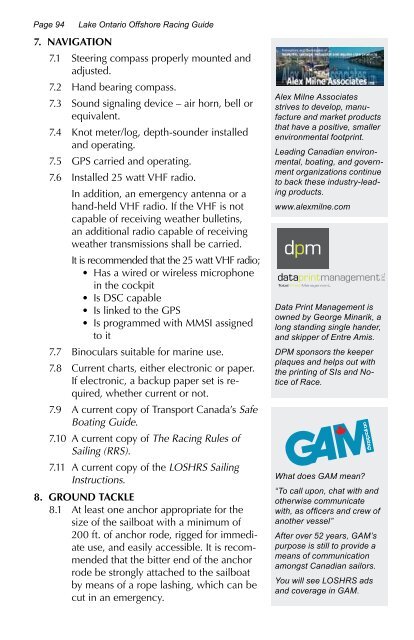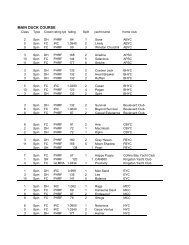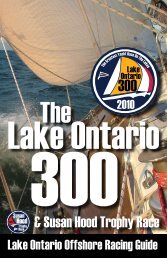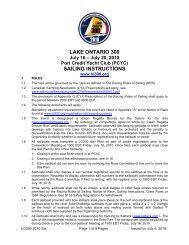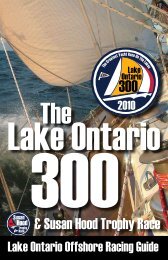Create successful ePaper yourself
Turn your PDF publications into a flip-book with our unique Google optimized e-Paper software.
Page 94 <strong>Lake</strong> <strong>Ontario</strong> <strong>Offshore</strong> Racing Guide <strong>Lake</strong> <strong>Ontario</strong> <strong>Offshore</strong> Racing Guide Page 95<br />
7. NAVIGATION<br />
7.1 Steering compass properly mounted and<br />
adjusted.<br />
7.2 Hand bearing compass.<br />
7.3 Sound signaling device – air horn, bell or<br />
equivalent.<br />
7.4 Knot meter/log, depth-sounder installed<br />
and operating.<br />
7.5 GPS carried and operating.<br />
7.6 Installed 25 watt VHF radio.<br />
In addition, an emergency antenna or a<br />
hand-held VHF radio. If the VHF is not<br />
capable of receiving weather bulletins,<br />
an additional radio capable of receiving<br />
weather transmissions shall be carried.<br />
It is recommended that the 25 watt VHF radio;<br />
• Has a wired or wireless microphone<br />
in the cockpit<br />
• Is DSC capable<br />
• Is linked to the GPS<br />
• Is programmed with MMSI assigned<br />
to it<br />
7.7 Binoculars suitable for marine use.<br />
7.8 Current charts, either electronic or paper.<br />
If electronic, a backup paper set is required,<br />
whether current or not.<br />
7.9 A current copy of Transport Canada’s Safe<br />
Boating Guide.<br />
7.10 A current copy of The Racing Rules of<br />
Sailing (RRS).<br />
7.11 A current copy of the LOSHRS Sailing<br />
Instructions.<br />
8. GROUND TACKLE<br />
8.1 At least one anchor appropriate for the<br />
size of the sailboat with a minimum of<br />
200 ft. of anchor rode, rigged for immediate<br />
use, and easily accessible. It is recommended<br />
that the bitter end of the anchor<br />
rode be strongly attached to the sailboat<br />
by means of a rope lashing, which can be<br />
cut in an emergency.<br />
Alex Milne Associates<br />
strives to develop, manufacture<br />
and market products<br />
that have a positive, smaller<br />
environmental footprint.<br />
Leading Canadian environmental,<br />
boating, and government<br />
organizations continue<br />
to back these industry-leading<br />
products.<br />
www.alexmilne.com<br />
Data Print Management is<br />
owned by George Minarik, a<br />
long standing single hander,<br />
and skipper of Entre Amis.<br />
DPM sponsors the keeper<br />
plaques and helps out with<br />
the printing of SIs and Notice<br />
of Race.<br />
What does GAM mean?<br />
“To call upon, chat with and<br />
otherwise communicate<br />
with, as officers and crew of<br />
another vessel”<br />
After over 52 years, GAM’s<br />
purpose is still to provide a<br />
means of communication<br />
amongst Canadian sailors.<br />
You will see LOSHRS ads<br />
and coverage in GAM.<br />
9. LIFE SAVING EQUIPMENT<br />
9.1 Approved life jacket or personal floatation device (PFD), with whistle<br />
and waterproof light attached. It is recommended that the PFD be<br />
worn at all times while on deck. It is recommended that a waterproof<br />
hand-held VHF radio be securely attached to the life jacket.<br />
9.2 Adequate safety harness and tether for each crewmember. It is recommended<br />
that this have a three point connection.<br />
9.3 Approved life-buoy with whistle, waterproof self-activating light,<br />
drogue and man-overboard pole. The man-overboard pole shall be<br />
permanently extended. It is recommended that it be attached to the<br />
life-buoy. This equipment shall be mounted close to the helm position<br />
and rigged for instant deployment.<br />
9.4 Buoyant heaving line, at least 50 ft. long, carried on deck close to the<br />
helm position and ready for use. The bitter end shall be securely attached<br />
to the sailboat.<br />
9.5 Boarding ladder or other means of re-boarding from the water.<br />
10. EMERGENCY EQUIPMENT<br />
10.1 An adequate means of reefing the mainsail by at least 30% of the luff<br />
length shall be installed (15% shall suffice if a storm jib, number 4 jib,<br />
or roller furling genoa is on board).<br />
10.2 A storm jib is recommended. A furling headsail does not qualify as a<br />
storm jib. The recommended sail area should not exceed 5% of the<br />
height of the fore triangle squared and should have a luff minimum<br />
length 65% of the height of the fore triangle. Any storm or heavyweather<br />
jib shall have a luff wire.<br />
10.4 Effective emergency steering equipment capable of steering the sailboat.<br />
An emergency tiller is required.<br />
10.5 A selection of tools including a hack saw or rigging cutter capable of<br />
cutting the largest diameter of standing rigging aboard the sailboat,<br />
stored in an easily accessible location.<br />
10.6 Approved distress signals are considered to be a minimum requirement.<br />
Distress signals shall be stored in a watertight container in an<br />
easily accessible location.<br />
11. MISCELLANEOUS EQUIPMENT<br />
11.1 Three waterproof flashlights capable of illuminating the ticklers on<br />
the sailboats headsail complete with spare batteries and bulbs, one of<br />
these shall have at least a 3” diameter lens. There is no requirement to<br />
carry spare bulbs for LED flashlights.<br />
11.2 First aid kit and manual.<br />
11.3 Radar reflector assembled and mounted.


